
Marocchino is a coffee drink created in Alessandria, Italy. [1] [2]

Marocchino is a coffee drink created in Alessandria, Italy. [1] [2]
Generally, the glass cup is first dusted with cocoa powder, then topped with milk froth and espresso, with a second dusting of cocoa on top.
It is served in a small glass and consists of a shot of espresso (sometimes a small shot, or ristretto), cocoa powder and milk froth. In some regions of northern Italy, thick hot cocoa is added. [3] [4] In Alba, Piedmont, the home of the Italian chocolate giant Ferrero, Nutella is used. The name marocchino (Italian for 'Moroccan') is derived from its colour, as marocchino was a type of light brown leather (see Morocco leather) used in the 1930s to make hair bands. [5] [6]

Cappuccino is an espresso-based coffee drink that is traditionally prepared with steamed milk including a layer of milk foam.
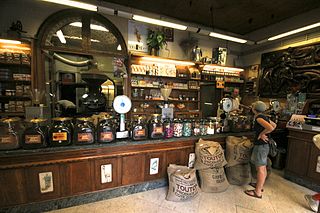
Italians are well known for their special attention to the preparation, the selection of the blends, and the use of accessories when creating many types of coffees. Many of the types of coffee preparation known today also have their roots here. The main coffee port in Italy is Trieste where there is also a lot of coffee processing industry. Italian coffee consumption, often espresso, is highest in the city of Trieste, with an average of 1500 cups of coffee per person per year. That is about twice as much as is usually drunk in Italy.

Caffè latte, often shortened to just latte in English, is a coffee drink of Italian origin made with espresso and steamed milk, traditionally served in a glass. Variants include the chocolate-flavored mocha or replacing the coffee with another beverage base such as masala chai, mate, matcha, turmeric or rooibos; alternatives to milk, such as soy milk, almond milk or oat milk, are also used.

Caffè macchiato, sometimes called espresso macchiato, is an espresso coffee drink with a small amount of milk, usually foamed. In Italian, macchiato means 'stained' or 'spotted', so the literal translation of caffè macchiato is 'stained coffee' or 'marked coffee'.

Hot chocolate, also known as hot cocoa or drinking chocolate, is a heated drink consisting of shaved or melted chocolate or cocoa powder, heated milk or water, and usually a sweetener. It is often garnished with whipped cream or marshmallows. Hot chocolate made with melted chocolate is sometimes called drinking chocolate, characterized by less sweetness and a thicker consistency.

Café au lait is coffee with hot milk added. It differs from white coffee, which is coffee with cold milk or other whiteners added.
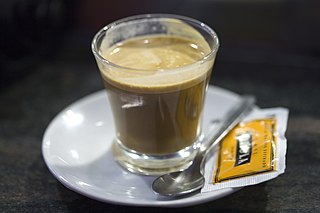
A cortado is a Spanish beverage consisting of espresso mixed with a roughly equal amount of warm milk to reduce the acidity, although the exact ratios have considerable regional variation. The milk in a cortado is steamed, but not frothy and "texturized" as in many Italian coffee drinks. The cortado is commonly served all over Spain. The word cortado is the past participle of the Spanish verb cortar, in the sense of "dilute", and can refer variously to either coffee or espresso drinks throughout Spanish and Portuguese speaking countries.
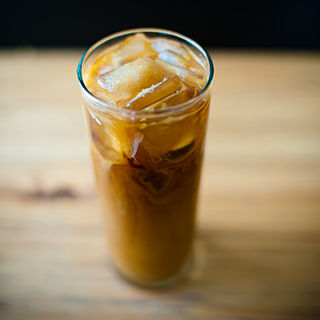
Iced coffee is a coffee beverage served cold. It may be prepared either by brewing coffee normally and then serving it over ice or in cold milk or by brewing the coffee cold. In hot brewing, sweeteners and flavoring may be added before cooling, as they dissolve faster. Iced coffee can also be sweetened with pre-dissolved sugar in water.

A caffè mocha, also called mocaccino, is a chocolate-flavoured warm beverage that is a variant of a caffè latte, commonly served in a glass rather than a mug. Other commonly used spellings are mochaccino and also mochachino. The name is derived from the city of Mokha, Taiz Governorate, Yemen, which was one of the centres of early coffee trade. Like latte, the name is commonly shortened to just mocha.

Latte macchiato is a coffee beverage. The name is Italian for 'stained milk' or 'marked milk', referring to the way the drink is prepared by pouring a shot of espresso into steamed milk. It is a play on espresso macchiato, an older drink consisting of espresso marked with a dollop or two of milk or cream.

Café Cubano is a type of espresso that originated in Cuba. Specifically, it refers to an espresso shot which is sweetened. However, the name is sometimes used to refer to coffee based drinks that include Cuban espresso as the main ingredient, such as café con leche.
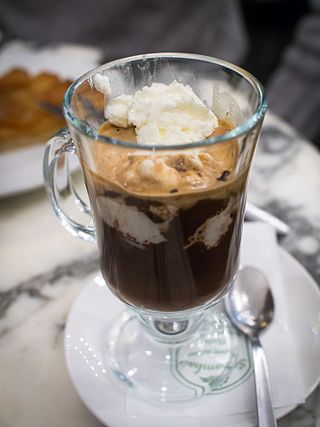
Bicerin is a traditional hot drink native to Turin, Italy, made of espresso, drinking chocolate, and milk served layered in a small glass.
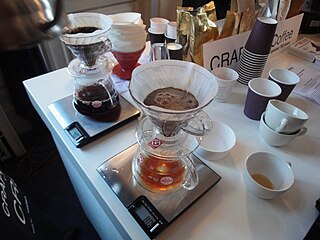
Coffee preparation is the process of turning coffee beans into liquid coffee. While the particular steps vary with the type of coffee and with the raw materials, the process includes four basic steps: raw coffee beans must be roasted, the roasted coffee beans must then be ground, and the ground coffee must then be mixed with hot or cold water for a specific time (brewed), the liquid coffee extraction must be separated from the used grounds, and finally, if desired, the extracted coffee is combined with other elements of the desired beverage, such as sweeteners, dairy products, dairy alternatives, or toppings.

Milk coffee is a category of coffee-based drinks made with milk. Johan Nieuhof, the Dutch ambassador to China, is credited as the first person to drink coffee with milk when he experimented with it around 1660.

Oliang, commonly known as Thai iced coffee, is a popular Thai beverage. Oliang is prepared from a mixture of Robusta coffee grounds, brown sugar, and various grains and seeds like cardamom, corn, soybeans, rice, and sesame seeds. The drink is noted for its coffee aroma and smoky notes from high-roasted grains and seeds.
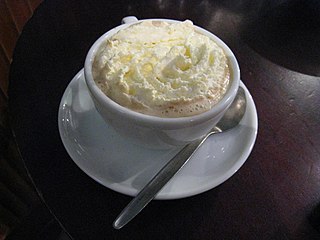
Espresso con panna is a single or double shot of espresso topped with whipped cream. In France and in the United Kingdom it is known as café viennois.
Espressino is an Italian coffee drink originating in the southern region of Apulia. Espressino is usually served in a demitasse.

A milk frother is a utensil for making milk froth, typically to be added to coffee. It aerates the milk, creating a thick but light foam. Milk frothers were introduced through the use of espresso machines that contained steamed wands that would froth steamed milk. Although created in Italy, the espresso machine and steam wands were exported internationally to other countries, and frothed milk was introduced around the world.